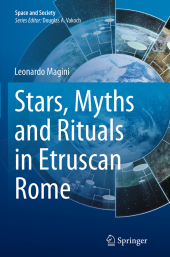 Neuerscheinungen 2016Stand: 2020-02-01 |
Schnellsuche
ISBN/Stichwort/Autor
|
Herderstraße 10
10625 Berlin
Tel.: 030 315 714 16
Fax 030 315 714 14
info@buchspektrum.de |

Leonardo Magini
Stars, Myths and Rituals in Etruscan Rome
Softcover reprint of the original 1st ed. 2015. 2016. xxxi, 181 S. 59 SW-Abb. 235 mm
Verlag/Jahr: SPRINGER, BERLIN; SPRINGER INTERNATIONAL PUBLISHING 2016
ISBN: 3-319-36001-9 (3319360019)
Neue ISBN: 978-3-319-36001-0 (9783319360010)
Preis und Lieferzeit: Bitte klicken
This book offers a detailed and fascinating picture of the astonishing astronomical knowledge on which the Roman calendar, traditionally attributed to the king Numa Pompilius (reign 715-673 B.C.), was based. This knowledge, of Mesopotamian origins, related mainly to the planetary movements and to the occurrence of eclipses in the solar system. The author explains the Numan year and cycle and illustrates clearly how astronomical phenomena exerted a powerful influence over both public and private life. A series of concise chapters examine the dates of the Roman festivals, describe the related rites and myths and place the festivals in relation to the planetary movements and astronomical events. Special reference is made to the movements of the moon and Venus, their relation to the language of myth, and the particular significance that Venus was considered to have for female fertility. The book clearly demonstrates the depth of astronomical knowledge reflected in the Roman religious calendar and the designated festive days. It will appeal both to learned connoisseurs and to amateurs with a particular interest in the subject.
The Beginning of Astronomical Time and the Feriae Martis.- The Numan Year, the Romulean Year and the Feriale antiquissimum.- The Names of Etruscan and Roman Months.- The Numan Cycle.- The Numan Year and Cycle, and the Motion of the Moon.- The Numan Cycle and the Movements of the Sun, the Moon and Venus.- The Solar New Year on March 8 or 9.- The Movements of the Moon and Venus and the Language of Myth.- The Motion of Venus.- The Movements of Venus (and the Moon), Female Fertility, and the Feast Days of Veneralia and Matralia.- The Length of Pregnancy, the Solar New Year, and the Feasts of Matronalia and Liberalia.- The Solstice Feasts: Fors Fortuna and Saturnalia.- Solar Eclipses, Lunar Eclipses and the Cycle of Saros.- The cycle of Saros and the Feast Days of Feriae Martis and Anna Perenna.- The Frequency of Solar and Lunar Eclipses, and the Festivities of the Numan Year.- Roman and Mesopotamian Eclipses: the Feast Days of Regifugium and Vestalia.- The Revolution of the Line of Nodes, and the Feast Days of October Equus, Fordicidia and Parilia.- The Ascendant Node at the First Point of Aries, and the Festival of Summanus.- The Revolution of the Line of the Apsides, and the Feast of Compitalia.- Composition of the Revolutions of the Lines of Nodes and Apsides.- The Numan Cycle as a Reference Framework for Celestial Motion.- The Movements of the Superior Planets and the Ancilia, the "Sacred Shields".- The Heavens of the Fixed Stars and their Custodian, Janus.- From the Robigalia on April 25 to the Entrance of the Sun in Aries for the Festivity of Anna Perenna on March 15.- The Entrance of the Sun in Aries to its Entrance in Pisces for the Terminalia on February 23, and the Vespertine Rise of Arcturus.- The Vespertine Rising of Arcturus for the Terminalia on February 23 and the Relationship Between the Romulean and Numan calendars.- Reform of the Romulean Year and the Transition to the Numan Year.- (Inevitable) Conclusion: per aspera ad astra.


